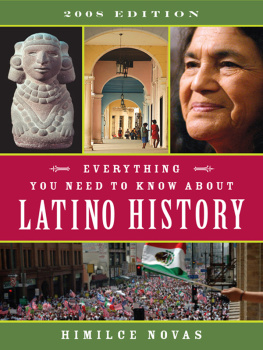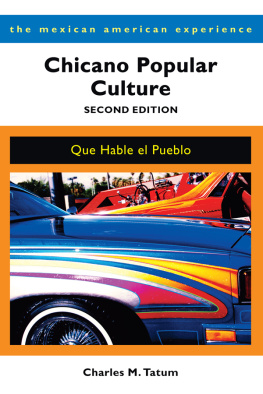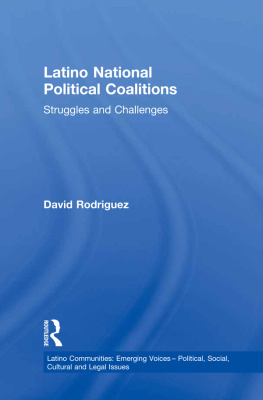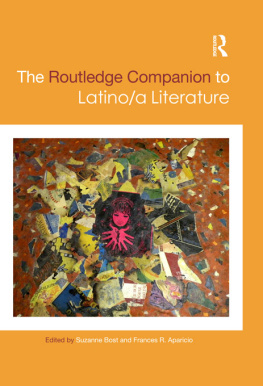Thank you for buying this ebook, published by NYU Press.
Sign up for our e-newsletters to receive information about forthcoming books, special discounts, and more!
Sign Up!
About NYU Press
A publisher of original scholarship since its founding in 1916, New York University Press Produces more than 100 new books each year, with a backlist of 3,000 titles in print. Working across the humanities and social sciences, NYU Press has award-winning lists in sociology, law, cultural and American studies, religion, American history, anthropology, politics, criminology, media and communication, literary studies, and psychology.
LATINO/A POPULAR CULTURE
EDITED BY MICHELLE HABELL-PALLN AND MARY ROMERO
LATINO/A POPULAR CULTURE
NEW YORK UNIVERSITY PRESS
New York and London
2002 by New York University
The Buena Vista Social Club: The Racial Politics of Nostalgia 2002
by Tanya Kater Hernndez
All rights reserved
Library of Congress Cataloging-in-Publication Data
Latino/a popular culture / edited by Michelle Habell-Palln and
Mary Romero.
p. cm.
Includes bibliographical references and index.
ISBN 0-8147-3624-6 ISBN 0-8147-3625-4 (pbk.)
1. Hispanic AmericansEthnic identity. 2. Hispanic Americans and
mass media. 3. Popular cultureUnited States. 4. Hispanic Americans
Social life and customs. 5. Hispanic American arts. 6. Hispanic American
athletes. I. Habell-Palln, Michelle. II. Romero, Mary.
E184.S75 L3554 2002
305.868073dc21 2001007962
New York University Press books are printed on acid-free paper, and their binding materials are chosen for strength and durability.
Manufactured in the United States of America
10 9 8 7 6 5 4 3 2 1
Contents
Mary Romero and Michelle Habell-Palln
Arlene Dvila
Frances Negrn-Muntaner
Tanya Kater Hernndez
Luz Calvo
Ana Patricia Rodrguez
Josh Kun
Deborah R.Vargas
Raquel Rivera
Theater and Art
Alberto Sandoval-Snchez
Melissa A. Fitch
Michelle Habell-Palln
William A. Nericcio
Juan Velasco
Adrian Burgos, Jr.
Christopher A. Shinn
Gregory Rodriguez
Acknowledgments
We have many people to thank for their help in editing this volume and in shaping Latino/a Popular Culture into a multiethnic and multidiscipli-nary project. Our greatest appreciation goes to our contributors for their fine work and willingness to be part of this project. We are grateful for the encouragement Eric Zinner offered us as we developed our ideas into a proposal and eventually into this volume. We are indebted to the scholars who generously participated in roundtable discussions at the American Studies Association and Latin American Studies Association: Frances Aparicio, Susana Chvez-Silverman, Ricardo Ortiz, Jaime Crdenas, Keta Miranda, Margarita Barcel, Adrian Burgos, Luz Calvo, and Deborah Vargas. Challenging questions and comments were helpful in shaping this collection, particularly those from Eric Avila, Ed Morales, Rick Bonus, and Catriona Esquibel. We acknowledge the insightful work of LatCrit scholars who have journeyed into popular culture in their quest to understand justice. We are particularly grateful to Kevin Johnson, Steve Bender, Ediberto Roman, and Pedro A. Malavet for sharing their recent publications and forthcoming articles. Kevin Johnson offered valuable suggestions and generously shared resources. Eric Margolis and Raul Villa graciously provided last-minute comments. We received institutional support from the Department of American Ethnic Studies, University of Washington, the School of Justice Studies, and the Publication Assistance Center in the College of Public Programs at Arizona State University. Finally, we would like to thank our partners, Jaime Crdenas and Eric Margolis, without whose support, encouragement, and patience this project would not have been possible. A special thanks to Diane Gamboa for creating the art that appears on the cover of this book. No other artist could have expressed the spirit of our work as well as she.
Introduction
Mary Romero and Michelle Habell-Palln
Headlines:
2000 Census Shows Latino Boom1
Census Jolts Business World: Corporate America Suddenly Discovering the Latino Market2
Bush: Respect Mexican Immigrants; President and Responding Democrats Broadcast in Spanish3
Guard Stopped the Mexican Pediatrician Because of Profiling, Her Attorney Charges4
Activists Say Border Patrol Targets All Latinos5
Martin Kicks Off Inaugural Festivities; Bush Shares Stage with Pop Sensation6
WHILE LATINO AND Latina images in mainstream news and in commercial and oppositional popular culture in the United States suggest a Latin explosion at center stage, the representations and circulating symbols are contradictorycelebrated and contested. How are we to understand the image of Ricky Martin shaking his inaugural bonbon with George W. Bush at the foot of the Lincoln Memorial or Bushs Cinco de Mayo proclamation that mi Casa Blanca, es su Casa Blanca?7 How do the symbolic embrace of and dance with Ricky MartinLatino pop star par excellenceby the leader of the nation (and the so-called free world) contradict and mask the nations current and historical record of treatment toward Latinos at home and abroad?8 Such public symbolism compels us to mark a new period in the struggle to represent La-tinidad. Let us consider the provocative image of Ricky and George W.s dance as a supreme example of the politics of image employed by the dominant culture to define the place of Latinas and Latinos at this historical juncture.9 Within this image of the dancing menone the son of a powerful, wealthy WASP family, the other a sexually ambiguous and powerful pop icon from the former U.S. colony and current commonwealth of Puerto Ricolies what George Lipsitz described as the sedimented historical currents within popular culture.10 Concentrated within the image are layered histories of imperialism, racism, class domination, patriarchy, and heterosexism. At the same time, the image speaks to new geopolitical and economic realities that implicate Latinos and Latin America.
The volumes aim is to examine the ways American popular culture has been defining Latina and Latino during this millennial transition period. The various essays were selected, in part, because the authors interrogate the ways popular culture provides narratives about the roles Latinos have played as part of the national body in the past, as well as the roles they may or may not play in the future. As emergent signifiers, Latina and Latino have no fixed definition; historical and social locations create shifting fields of meaning. The power to define these terms is political and economic and plays out symbolically in the imaginative products of the popular culture machine. While recognizing the apparatus of cultural production as a central industry of capitalism, we also note that popular culture takes no fixed form or necessary ideological message. It is a contested terrain; historical circumstances shape production, reception, and appropriation, determining how plays, films, videos, and music operate in the spheres of popular culture. Popular cultural expressions range from blatant appropriation of cultural stereotypes for mass marketing like Chiquita Banana and the Frito Bandito to powerful oppositional forces like the Teatro Campesino and hip hop. The volume comfortably moves beyond the task of defining Latino popular culture once and for all, into the more fruitful juxta-position and cross-examination of the mosaic of contradictory and congratulatory images thrown up by the mass media.








